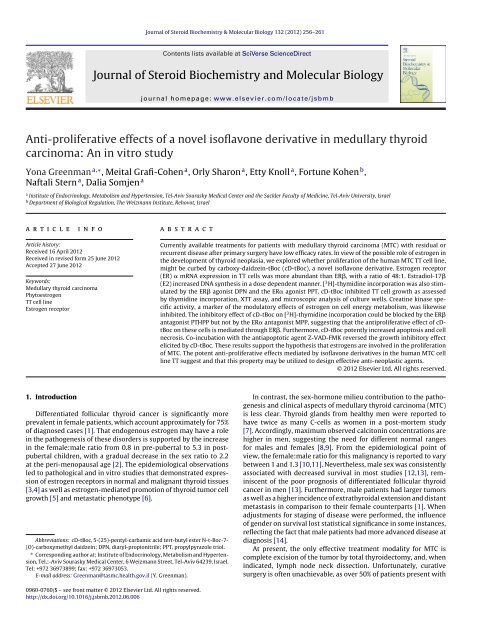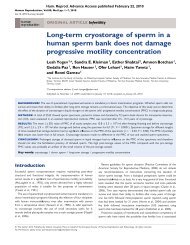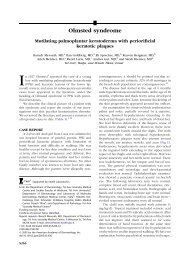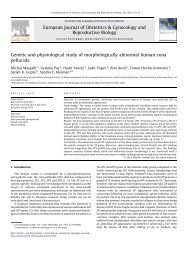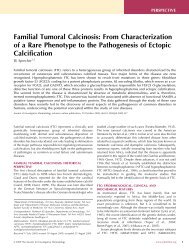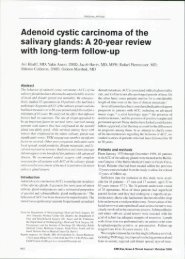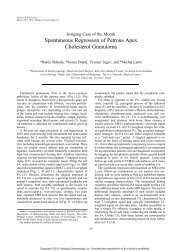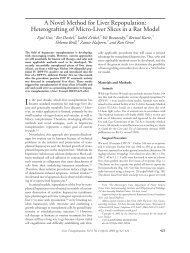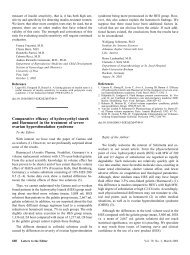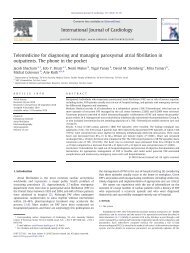Anti-proliferative effects of a novel isoflavone derivative in medullary ...
Anti-proliferative effects of a novel isoflavone derivative in medullary ...
Anti-proliferative effects of a novel isoflavone derivative in medullary ...
Create successful ePaper yourself
Turn your PDF publications into a flip-book with our unique Google optimized e-Paper software.
Journal <strong>of</strong> Steroid Biochemistry & Molecular Biology 132 (2012) 256– 261<br />
Contents lists available at SciVerse ScienceDirect<br />
Journal <strong>of</strong> Steroid Biochemistry and Molecular Biology<br />
jo u r n al hom epage: www.elsevier.com/locate/jsbmb<br />
<strong>Anti</strong>-<strong>proliferative</strong> <strong>effects</strong> <strong>of</strong> a <strong>novel</strong> is<strong>of</strong>lavone <strong>derivative</strong> <strong>in</strong> <strong>medullary</strong> thyroid<br />
carc<strong>in</strong>oma: An <strong>in</strong> vitro study<br />
Yona Greenman a,∗ , Meital Grafi-Cohen a , Orly Sharon a , Etty Knoll a , Fortune Kohen b ,<br />
Naftali Stern a , Dalia Somjen a<br />
a Institute <strong>of</strong> Endocr<strong>in</strong>ology, Metabolism and Hypertension, Tel-Aviv Sourasky Medical Center and the Sackler Faculty <strong>of</strong> Medic<strong>in</strong>e, Tel-Aviv University, Israel<br />
b Department <strong>of</strong> Biological Regulation, The Weizmann Institute, Rehovot, Israel<br />
a r t i c l e i n f o<br />
Article history:<br />
Received 16 April 2012<br />
Received <strong>in</strong> revised form 25 June 2012<br />
Accepted 27 June 2012<br />
Keywords:<br />
Medullary thyroid carc<strong>in</strong>oma<br />
Phytoestrogen<br />
TT cell l<strong>in</strong>e<br />
Estrogen receptor<br />
1. Introduction<br />
a b s t r a c t<br />
Differentiated follicular thyroid cancer is significantly more<br />
prevalent <strong>in</strong> female patients, which account approximately for 75%<br />
<strong>of</strong> diagnosed cases [1]. That endogenous estrogen may have a role<br />
<strong>in</strong> the pathogenesis <strong>of</strong> these disorders is supported by the <strong>in</strong>crease<br />
<strong>in</strong> the female:male ratio from 0.8 <strong>in</strong> pre-pubertal to 5.3 <strong>in</strong> postpubertal<br />
children, with a gradual decrease <strong>in</strong> the sex ratio to 2.2<br />
at the peri-menopausal age [2]. The epidemiological observations<br />
led to pathological and <strong>in</strong> vitro studies that demonstrated expression<br />
<strong>of</strong> estrogen receptors <strong>in</strong> normal and malignant thyroid tissues<br />
[3,4] as well as estrogen-mediated promotion <strong>of</strong> thyroid tumor cell<br />
growth [5] and metastatic phenotype [6].<br />
Abbreviations: cD-tBoc, 5-(25)-pentyl-carbamic acid tert-butyl ester N-t-Boc-7-<br />
(O)-carboxymethyl daidze<strong>in</strong>; DPN, diaryl-propionitrile; PPT, propylpyrazole triol.<br />
∗ Correspond<strong>in</strong>g author at: Institute <strong>of</strong> Endocr<strong>in</strong>ology, Metabolism and Hypertension,<br />
Tel.:-Aviv Sourasky Medical Center, 6 Weizmann Street, Tel-Aviv 64239, Israel.<br />
Tel: +972 36973899; fax: +972 36973053.<br />
E-mail address: Greenman@tasmc.health.gov.il (Y. Greenman).<br />
0960-0760/$ – see front matter ©<br />
2012 Elsevier Ltd. All rights reserved.<br />
http://dx.doi.org/10.1016/j.jsbmb.2012.06.006<br />
Currently available treatments for patients with <strong>medullary</strong> thyroid carc<strong>in</strong>oma (MTC) with residual or<br />
recurrent disease after primary surgery have low efficacy rates. In view <strong>of</strong> the possible role <strong>of</strong> estrogen <strong>in</strong><br />
the development <strong>of</strong> thyroid neoplasia, we explored whether proliferation <strong>of</strong> the human MTC TT cell l<strong>in</strong>e,<br />
might be curbed by carboxy-daidze<strong>in</strong>-tBoc (cD-tBoc), a <strong>novel</strong> is<strong>of</strong>lavone <strong>derivative</strong>. Estrogen receptor<br />
(ER) � mRNA expression <strong>in</strong> TT cells was more abundant than ER�, with a ratio <strong>of</strong> 48:1. Estradiol-17�<br />
(E2) <strong>in</strong>creased DNA synthesis <strong>in</strong> a dose dependent manner. [ 3 H]-thymid<strong>in</strong>e <strong>in</strong>corporation was also stimulated<br />
by the ER� agonist DPN and the ER� agonist PPT. cD-tBoc <strong>in</strong>hibited TT cell growth as assessed<br />
by thymid<strong>in</strong>e <strong>in</strong>corporation, XTT assay, and microscopic analysis <strong>of</strong> culture wells. Creat<strong>in</strong>e k<strong>in</strong>ase specific<br />
activity, a marker <strong>of</strong> the modulatory <strong>effects</strong> <strong>of</strong> estrogen on cell energy metabolism, was likewise<br />
<strong>in</strong>hibited. The <strong>in</strong>hibitory effect <strong>of</strong> cD-tBoc on [ 3 H]-thymid<strong>in</strong>e <strong>in</strong>corporation could be blocked by the ER�<br />
antagonist PTHPP but not by the ER� antagonist MPP, suggest<strong>in</strong>g that the anti<strong>proliferative</strong> effect <strong>of</strong> cDtBoc<br />
on these cells is mediated through ER�. Furthermore, cD-tBoc potently <strong>in</strong>creased apoptosis and cell<br />
necrosis. Co-<strong>in</strong>cubation with the antiapoptotic agent Z-VAD-FMK reversed the growth <strong>in</strong>hibitory effect<br />
elicited by cD-tBoc. These results support the hypothesis that estrogens are <strong>in</strong>volved <strong>in</strong> the proliferation<br />
<strong>of</strong> MTC. The potent anti-<strong>proliferative</strong> <strong>effects</strong> mediated by is<strong>of</strong>lavone <strong>derivative</strong>s <strong>in</strong> the human MTC cell<br />
l<strong>in</strong>e TT suggest and that this property may be utilized to design effective anti-neoplastic agents.<br />
© 2012 Elsevier Ltd. All rights reserved.<br />
In contrast, the sex-hormone milieu contribution to the pathogenesis<br />
and cl<strong>in</strong>ical aspects <strong>of</strong> <strong>medullary</strong> thyroid carc<strong>in</strong>oma (MTC)<br />
is less clear. Thyroid glands from healthy men were reported to<br />
have twice as many C-cells as women <strong>in</strong> a post-mortem study<br />
[7]. Accord<strong>in</strong>gly, maximum observed calciton<strong>in</strong> concentrations are<br />
higher <strong>in</strong> men, suggest<strong>in</strong>g the need for different normal ranges<br />
for males and females [8,9]. From the epidemiological po<strong>in</strong>t <strong>of</strong><br />
view, the female:male ratio for this malignancy is reported to vary<br />
between 1 and 1.3 [10,11]. Nevertheless, male sex was consistently<br />
associated with decreased survival <strong>in</strong> most studies [12,13], rem<strong>in</strong>iscent<br />
<strong>of</strong> the poor prognosis <strong>of</strong> differentiated follicular thyroid<br />
cancer <strong>in</strong> men [13]. Furthermore, male patients had larger tumors<br />
as well as a higher <strong>in</strong>cidence <strong>of</strong> extrathyroidal extension and distant<br />
metastasis <strong>in</strong> comparison to their female counterparts [1]. When<br />
adjustments for stag<strong>in</strong>g <strong>of</strong> disease were performed, the <strong>in</strong>fluence<br />
<strong>of</strong> gender on survival lost statistical significance <strong>in</strong> some <strong>in</strong>stances,<br />
reflect<strong>in</strong>g the fact that male patients had more advanced disease at<br />
diagnosis [14].<br />
At present, the only effective treatment modality for MTC is<br />
complete excision <strong>of</strong> the tumor by total thyroidectomy, and, when<br />
<strong>in</strong>dicated, lymph node neck dissection. Unfortunately, curative<br />
surgery is <strong>of</strong>ten unachievable, as over 50% <strong>of</strong> patients present with
Y. Greenman et al. / Journal <strong>of</strong> Steroid Biochemistry & Molecular Biology 132 (2012) 256– 261 257<br />
stage III or IV disease at the time <strong>of</strong> diagnosis [11]. Currently available<br />
treatments for patients with residual or recurrent disease after<br />
primary surgery have low efficacy rates. Chemotherapeutical regimens<br />
may achieve partial remission rates <strong>in</strong> the range <strong>of</strong> 10–20%,<br />
that are generally short lived [15]. Therefore cytotoxic chemotherapy<br />
is not recommended as first-l<strong>in</strong>e therapy for these patients.<br />
Similarly, the role <strong>of</strong> adjunctive external beam irradiation to the<br />
neck <strong>in</strong> MTC is controversial, and its use is considered only <strong>in</strong><br />
selected cases [15]. In the absence <strong>of</strong> established effective systemic<br />
therapies, the development <strong>of</strong> new drugs for MTC has been an area<br />
<strong>of</strong> <strong>in</strong>tense research. Compounds that <strong>in</strong>hibit receptor or <strong>in</strong>tracellular<br />
k<strong>in</strong>ases, and <strong>in</strong> particular molecules that block RET k<strong>in</strong>ase<br />
activity or downstream signal<strong>in</strong>g pathways have shown promise <strong>in</strong><br />
cl<strong>in</strong>ical trials [16]. Nevertheless, the low rate <strong>of</strong> partial responses<br />
and absence <strong>of</strong> complete responses <strong>in</strong> the various trials should<br />
encourage the development <strong>of</strong> different treatment strategies.<br />
In view <strong>of</strong> the putative role <strong>of</strong> estrogen <strong>in</strong> the development <strong>of</strong><br />
thyroid neoplasia as implied by the data described here<strong>in</strong>, target<strong>in</strong>g<br />
<strong>of</strong> estrogen receptors could be an attractive strategy for the<br />
management <strong>of</strong> MTC. Here we explore whether proliferation <strong>of</strong><br />
the human MTC TT cell l<strong>in</strong>e, may be curbed by <strong>novel</strong> is<strong>of</strong>lavone<br />
<strong>derivative</strong>s generated <strong>in</strong> our laboratory, which possess potent anticancer<br />
<strong>effects</strong> <strong>in</strong> human ovarian cancer cells through <strong>in</strong>teraction<br />
with estrogen receptor (ER) � [17].<br />
2. Materials and methods<br />
2.1. Reagents<br />
All reagents were <strong>of</strong> analytical grade. Chemicals, steroids and<br />
PPT (ER� agonist) were purchased from Sigma (St. Louis, MI). DPN<br />
(ER� agonist), MPP (anti-ER�) and PTHPP (anti-ER�) were purchased<br />
from Tocris Bioscience (Bristol, UK). The apoptotic <strong>in</strong>hibitor<br />
Z-VADFMK Me ester was obta<strong>in</strong>ed from Axxora (San Diego, CA).<br />
Methyl-[ 3 H]-thymid<strong>in</strong>e (5 Ci/mmol) was obta<strong>in</strong>ed from New England<br />
Nuclear (Boston, MA). Synthesis <strong>of</strong> t-Boc <strong>derivative</strong>s <strong>of</strong> carboxy<br />
alkyl is<strong>of</strong>lavones were prepared as described previously [17] by<br />
Biol<strong>in</strong>e Innovations, Jerusalem, Israel.<br />
2.2. Cell culture<br />
The human <strong>medullary</strong> carc<strong>in</strong>oma cell l<strong>in</strong>e TT was purchased<br />
from the American Type Culture Collection (ATCC). Cells were cultured<br />
<strong>in</strong> Ham’s F12K medium with 2 mM l-glutam<strong>in</strong>e adjusted to<br />
conta<strong>in</strong> 1.5 g/L sodium bicarbonate and 10% fetal bov<strong>in</strong>e serum,<br />
grown to sub-confluence and then treated with various hormones<br />
or agents for 24 h as <strong>in</strong>dicated.<br />
2.3. Preparation <strong>of</strong> total RNA, RT-PCR and RNA quantification<br />
Total RNA from TT cells was extracted us<strong>in</strong>g the TRIzol reagent<br />
(Gibco Life Technologies) accord<strong>in</strong>g to the manufacturer’s <strong>in</strong>structions.<br />
Extracted RNA (1 �g) was then reverse transcribed us<strong>in</strong>g<br />
the RevertAid TM First Strand cDNA synthesis kit from Fermentas<br />
Life Science (St. Leon-Rot, Germany). mRNA expression was<br />
quantified with an ABI 7700 Real Time PCR System us<strong>in</strong>g specific<br />
primer probe sets for estrogen receptors (ER) � and � obta<strong>in</strong>ed from<br />
Applied Biosystems (Foster City, CA). Each RT-PCR conta<strong>in</strong>ed 12.5 �l<br />
TaqMan Universal PCR Master Mix, 1.25 �l Assays-on demand<br />
Gene Expression Assay Mix for either ER� (HS00174860M1) or<br />
ER� (HS00230957M1), 2.5 �l nuclease-free water, and 9 �l cDNA.<br />
Endogenous controls (RNAse P) were run <strong>in</strong> triplicate to assure<br />
repeatability. In this system, cycle threshold (CT) <strong>in</strong>dicates the fractional<br />
cycle number at which the reporter fluorescence generated<br />
by cleavage <strong>of</strong> the probe passes a fixed threshold above basel<strong>in</strong>e and<br />
�CT represents relative gene expression. The relative difference <strong>in</strong><br />
expression <strong>of</strong> the gene <strong>of</strong> <strong>in</strong>terest and <strong>of</strong> the <strong>in</strong>ternal reference gene<br />
is represented by ��CT. Changes <strong>of</strong> gene expression <strong>in</strong> relation to<br />
the calibrator are represented by 2 −�C T .<br />
2.4. Assessment <strong>of</strong> DNA synthesis<br />
TT cells were grown until sub-confluence, and then treated with<br />
various hormones or agents for 24 h as <strong>in</strong>dicated. At the end <strong>of</strong> <strong>in</strong>cubation,<br />
[ 3 H]-thymid<strong>in</strong>e was added for 2 h. Cells were then treated<br />
with 10% ice-cold trichloroacetic acid (TCA) for 5 m<strong>in</strong> and washed<br />
twice with 5% TCA and then with cold ethanol. The cellular layer was<br />
dissolved <strong>in</strong> 0.3 ml <strong>of</strong> 0.3 M NaOH, aliquots were taken for count<strong>in</strong>g<br />
radioactivity, and [ 3 H]-thymid<strong>in</strong>e <strong>in</strong>corporation <strong>in</strong>to DNA was<br />
calculated.<br />
2.5. Assessment <strong>of</strong> cell proliferation<br />
Cells were grown until sub-confluence and then treated with<br />
various compounds for 24 h as <strong>in</strong>dicated. At the end <strong>of</strong> <strong>in</strong>cubation,<br />
cell proliferation was assayed us<strong>in</strong>g the cell proliferation kit<br />
based on XTT colorimetric assay (Biological Industries, Kibbutz Beit<br />
Haemek, Israel).<br />
2.6. Assessment <strong>of</strong> cell death and detection <strong>of</strong> apoptosis and<br />
necrosis<br />
Cells were grown until sub-confluence and then treated with<br />
various compounds for 24 h as <strong>in</strong>dicated. At the end <strong>of</strong> <strong>in</strong>cubation,<br />
photometric enzyme-immunoassay for the quantitative<br />
<strong>in</strong> vitro determ<strong>in</strong>ation <strong>of</strong> cytoplasmic histone-associated-DNAfragments<br />
(mono- and oligo-nucleosomes) after <strong>in</strong>duced cell death<br />
was assayed us<strong>in</strong>g Cell Death Detection ELISA plus kit from Roche<br />
kit Molecular Biochemicals. This is a “sandwich” assay constructed<br />
to identify DNA fragments through the use <strong>of</strong> two antibodies, one<br />
aga<strong>in</strong>st histones and the second directed aga<strong>in</strong>st DNA. Cell necrosis<br />
was also assayed at the end <strong>of</strong> the <strong>in</strong>cubation by measur<strong>in</strong>g lactic<br />
dehydrogense (LDH) activity released to the culture medium from<br />
the cytoplasm <strong>of</strong> dis<strong>in</strong>tegrat<strong>in</strong>g cells us<strong>in</strong>g a standard commercial<br />
LDH assay (Advia Centaur, Siemens).<br />
2.7. Assessment <strong>of</strong> creat<strong>in</strong>e k<strong>in</strong>ase specific activity<br />
Cells were grown until sub-confluence, treated for 24 h with the<br />
various hormones as specified, and were then collected and homogenized<br />
<strong>in</strong> an extraction buffer as previously described. Supernatant<br />
extracts were obta<strong>in</strong>ed by centrifugation <strong>of</strong> homogenates at<br />
14,000 × g for 5 m<strong>in</strong> at 4 ◦ C <strong>in</strong> an Eppendorf micro centrifuge.<br />
Creat<strong>in</strong>e k<strong>in</strong>ase activity (CK) was assayed by a coupled spectrophotometric<br />
assay (17). Prote<strong>in</strong> was determ<strong>in</strong>ed by Coomassie blue dye<br />
b<strong>in</strong>d<strong>in</strong>g us<strong>in</strong>g bov<strong>in</strong>e serum album<strong>in</strong> (BSA) as the standard.<br />
2.8. Statistical analysis<br />
Results are expressed as mean ± SEM. Differences between the<br />
mean values obta<strong>in</strong>ed from the experimental and the control<br />
groups were evaluated by analysis <strong>of</strong> variance (ANOVA). A p value<br />
less than 0.05, was considered significant.<br />
3. Results<br />
3.1. Effect <strong>of</strong> E2 and specific ER˛ and ERˇ agonists and<br />
antagonists on DNA-synthesis and CK activity <strong>in</strong> the human<br />
<strong>medullary</strong> thyroid cancer TT cell l<strong>in</strong>e<br />
ER� mRNA was significantly more abundant than ER� <strong>in</strong><br />
the TT cell l<strong>in</strong>e, with a ratio <strong>of</strong> 48:1 (Fig. 1a). E2 elicited a
258 Y. Greenman et al. / Journal <strong>of</strong> Steroid Biochemistry & Molecular Biology 132 (2012) 256– 261<br />
Fig. 1. Estradiol-17(, ER� and ER� agonists stimulate DNA synthesis and CK activity <strong>in</strong> <strong>medullary</strong> thyroid carc<strong>in</strong>oma cell l<strong>in</strong>e TT. (a) ER� and ER� mRNA expression <strong>in</strong><br />
cultured human TT cells; (b) effect <strong>of</strong> treatment (24 h) with <strong>in</strong>creas<strong>in</strong>g concentrations <strong>of</strong> estradiol-17� (E2) on DNA synthesis, *p < 0.05; (c) effect <strong>of</strong> MPP (ER� antagonist)<br />
and PTHPP (ER� antagonist) on the stimulatory effect <strong>of</strong> E2, DPN (ER� agonist) and PPT (ER� agonist) on DNA synthesis, *p < 0.05; **p < 0.01 for the difference between<br />
hormonal treated and control treated cells; # p < 0.05 for the difference between hormone + antagonist treated and hormonal treated cells; and (d) <strong>effects</strong> <strong>of</strong> raloxifene on E2-,<br />
DPN- and PPT-<strong>in</strong>duced changes <strong>in</strong> CK specific activity, *p < 0.05 for the difference between hormonal treated and control treated cells; # p < 0.05 for the difference between<br />
hormone + Ral treated and hormonal treated cells.<br />
dose-dependent <strong>in</strong>crease <strong>in</strong> DNA synthesis <strong>in</strong> TT cells as assessed by<br />
[ 3 H]-thymid<strong>in</strong>e <strong>in</strong>corporation (Fig. 1b). Stimulation <strong>of</strong> proliferation<br />
occurred even at low concentrations <strong>of</strong> E2, which are equivalent to<br />
physiological E2 levels <strong>in</strong> adult females (0.3–3 nM). The ER� agonist<br />
DPN at low concentration (42 nM) stimulated [ 3 H]-thymid<strong>in</strong>e<br />
<strong>in</strong>corporation by 68% (similar to the extent <strong>of</strong> <strong>in</strong>crease <strong>in</strong> DNA<br />
synthesis achieved with E2 at similar concentration). Incubation<br />
with higher concentrations <strong>of</strong> DPN had no effect on cell proliferation.<br />
In contrast, <strong>in</strong>cubation <strong>of</strong> TT cells with a low concentration<br />
<strong>of</strong> the ER� agonist PPT (39 nM) had no effect, but at higher concentrations<br />
(390 nM) this agent caused a significant stimulation <strong>of</strong><br />
[ 3 H]-thymid<strong>in</strong>e <strong>in</strong>corporation (data not shown). Consequently, all<br />
subsequent experiments as described below were performed us<strong>in</strong>g<br />
DPN concentration <strong>of</strong> 42 nM and PPT concentration <strong>of</strong> 390 nM. The<br />
stimulatory effect <strong>of</strong> E2 (30 nM) on DNA synthesis was attenuated<br />
by co-<strong>in</strong>cubation <strong>of</strong> either the ER� specific antagonist MPP<br />
(150 nM) or the ER� specific antagonist PTHPP (150 nM), <strong>in</strong>dicat<strong>in</strong>g<br />
that the estrogen <strong>in</strong>duced proliferation <strong>in</strong> these cells is mediated by<br />
both ER� and ER� (Fig. 1c). Furthermore, the stimulatory effect <strong>of</strong><br />
the ER� agonist DPN on cell proliferation was more robustly <strong>in</strong>hibited<br />
by co-<strong>in</strong>cubation with the ER� antagonist PTHPP, than with<br />
MPP. Accord<strong>in</strong>gly, ER� mediated DNA synthesis by PPT was mostly<br />
<strong>in</strong>hibited by the specific ER� antagonist MPP (Fig. 1c). Nuclear<br />
receptor-dependent estrogenic activity, as measured by creat<strong>in</strong>e<br />
k<strong>in</strong>ase specific activity (CK activity), was significantly stimulated<br />
by E2 (30 nM), DPN (42 nM) and PPT (390 nM, Fig. 1d). Incubation<br />
with the selective estrogen receptor modulator (SERM) Raloxifene<br />
(Ral, 3 �M) that has tissue specific stimulatory or <strong>in</strong>hibitory activities,<br />
<strong>in</strong>duced CK activity <strong>in</strong> TT cells (Fig. 1d). On the other hand, Ral<br />
blocked E 2 and PPT but not DPN stimulation <strong>of</strong> CK activity, reflect<strong>in</strong>g<br />
its predom<strong>in</strong>ant antagonism <strong>of</strong> ER� over ER� (Fig. 1d). These<br />
results <strong>in</strong>dicate that despite the more pronounced mRNA expression<br />
<strong>of</strong> ER� <strong>in</strong> TT cells, both receptor is<strong>of</strong>orms significantly mediate<br />
E2 <strong>in</strong>duced proliferation <strong>in</strong> these cells.<br />
3.2. Effect <strong>of</strong> cD-tBoc on human TT cell l<strong>in</strong>e growth and survival<br />
<strong>in</strong> vitro<br />
cD-tBoc significantly <strong>in</strong>hibited DNA synthesis <strong>in</strong> cultured TT<br />
cells <strong>in</strong> a dose dependent manner rang<strong>in</strong>g from 0.0312 to 3.120 �M<br />
(Fig. 2a). Similar <strong>in</strong>hibitory <strong>effects</strong> were observed when cell proliferation<br />
was assessed by the XTT assay, with maximal suppression <strong>of</strong><br />
proliferation (70%) achieved at cD-tBoc concentration <strong>of</strong> 0.312 �M<br />
(not shown). Furthermore, cD-tBoc (3.12 �M) completely abrogated<br />
the <strong>proliferative</strong> effect <strong>of</strong> E2, as well as <strong>of</strong> the ER� agonist<br />
DPN, but not <strong>of</strong> the ER� agonist MPP (Fig. 2b). Concordant with<br />
this f<strong>in</strong>d<strong>in</strong>g, the cD-tBoc <strong>in</strong>hibitory effect on [ 3 H]-thymid<strong>in</strong>e <strong>in</strong>corporation<br />
could be blocked by PTHPP (anti-ER�) but not with MPP<br />
(anti-ER�), suggest<strong>in</strong>g that the anti<strong>proliferative</strong> effect <strong>of</strong> cD-tBoc<br />
on these cells is mediated through ER� (Fig. 2c). F<strong>in</strong>ally, basal CK<br />
activity, as well as E2 and DPN (but no PPT) stimulated CK activity<br />
was suppressed by co-treatment with cD-tBoc (Fig. 2d). Fig. 3<br />
depicts actual photographs <strong>of</strong> control and treated TT cells respond<strong>in</strong>g<br />
to this compound. Shown photographs were obta<strong>in</strong>ed follow<strong>in</strong>g<br />
24 h <strong>of</strong> culture with vehicle (Fig. 3a) or with cD-tBoc at 3 (Fig. 3b),<br />
30 (Fig. 3c) and 300 nM (Fig. 3d).<br />
3.3. cD-tBoc <strong>in</strong>duces thyroid cancer cell death through the<br />
<strong>in</strong>duction <strong>of</strong> apoptosis and necrosis<br />
cD-tBoc potently <strong>in</strong>creased apoptosis (1350–1750% stimulation<br />
<strong>of</strong> histone–DNA fragments), with the maximal effect be<strong>in</strong>g
Y. Greenman et al. / Journal <strong>of</strong> Steroid Biochemistry & Molecular Biology 132 (2012) 256– 261 259<br />
Fig. 2. cD-tBoc <strong>in</strong>hibits basal as well as E2 and ER� agonist stimulated DNA synthesis <strong>in</strong> TT cells. (a) Effect <strong>of</strong> cD-tBoc on basal DNA synthesis <strong>in</strong> cultured human TT cells,<br />
*p < 0.05 for the difference between hormonal treated and control treated cells; (b) effect <strong>of</strong> cD-tBoc on E2, DPN and PPT stimulated DNA synthesis <strong>in</strong> cultured human TT cells<br />
(% <strong>of</strong> control, *p < 0.05; **p < 0.01); (c) effect <strong>of</strong> co-treatment with ER� antagonist (MPP) or ER� antagonist (PTHPP) on cD-tBoc <strong>in</strong>duced <strong>in</strong>hibition <strong>of</strong> DNA synthesis, *p < 0.05;<br />
**p < 0.01 for the difference between cD-tBoc treated and control treated cells; # p < 0.05 for the difference between cD-tBoc + antagonist treated and cD-tBoc treated cells;<br />
and (d) effect <strong>of</strong> cD-tBoc on E2, DPN and PPT <strong>in</strong>duced CK activity <strong>in</strong> cultured human TT cells (% <strong>of</strong> control), *p < 0.05; # p < 0.05 for the difference between cD-tBoc + antagonist<br />
treated and cD-tBoc treated cells.<br />
Fig. 3. Effect <strong>of</strong> different doses <strong>of</strong> cD-tBoc on the morphology <strong>of</strong> cultured human TT cells (×20). (a) No treatment; (b) cD-tBoc 0.0312 �M; (c) cD-tBoc 0.312 �M; and (d)<br />
cD-tBoc 3.12 �M.
260 Y. Greenman et al. / Journal <strong>of</strong> Steroid Biochemistry & Molecular Biology 132 (2012) 256– 261<br />
Fig. 4. cD-tBoc <strong>in</strong>duces thyroid cancer TT cell death through the <strong>in</strong>duction <strong>of</strong> apoptosis and necrosis. (a) Effect <strong>of</strong> cD-tBoc on apoptotic cell death <strong>in</strong> cultured TT cell l<strong>in</strong>es<br />
as assessed by the detection <strong>of</strong> histone–DNA fragments, p < 0.001; (b) effect <strong>of</strong> the general apoptosis <strong>in</strong>hibitor ZV on the <strong>in</strong>hibitory effect <strong>of</strong> cD-tBoc on DNA synthesis <strong>in</strong><br />
cultured human TT cells, *p < 0.05 for the difference between cD-tBoc treated and control treated cells and # p < 0.05 for the difference <strong>of</strong> cD-tBoc treated + ZV compared to<br />
cD-tBoc treated alone; (c) effect <strong>of</strong> ZV on cD-tBoc <strong>in</strong>hibition <strong>of</strong> CK activity, *p < 0.05 for the difference between cD-tBoc treated and control treated cells and # p < 0.05 for the<br />
difference <strong>of</strong> cD-tBoc treated + ZV compared to cD-tBoc treated alone; and (d) effect <strong>of</strong> cD-tBoc on LDH activity, reflect<strong>in</strong>g cell necrosis <strong>in</strong> cultured human TT cells, *p < 0.05<br />
for the difference between cD-tBoc treated and control treated cells.<br />
already achieved at the lowest concentration tested (0.0312 �M)<br />
(Fig. 4a). Co-<strong>in</strong>cubation with the antiapoptotic agent ZV (Z-VAD-<br />
FMK) reversed the growth <strong>in</strong>hibitory effect elicited by cD-tBoc<br />
as measured by thymid<strong>in</strong>e <strong>in</strong>corporation (Fig. 4b), and CK activity<br />
(Fig. 4c), <strong>in</strong>dicat<strong>in</strong>g that cD-tBoc-<strong>in</strong>duced apoptosis is a major<br />
mechanism through which this compound retards growth <strong>in</strong> the<br />
TT cell l<strong>in</strong>e. F<strong>in</strong>ally, cD-tBoc <strong>in</strong>creased TT cell release <strong>of</strong> LDH by<br />
67% (Fig. 4d), reflect<strong>in</strong>g cell necrosis and thus <strong>in</strong>dicat<strong>in</strong>g that this<br />
is another pathway by which this compound <strong>in</strong>hibits cell proliferation.<br />
4. Discussion<br />
An <strong>in</strong>crease <strong>in</strong> calciton<strong>in</strong> secretion by normal thyroid C-cells as<br />
a result <strong>of</strong> estrogen stimulation has been demonstrated <strong>in</strong> vitro<br />
[18] as well as <strong>in</strong> animal models [19] and humans [20], thus suggest<strong>in</strong>g<br />
the presence <strong>of</strong> estrogen receptors <strong>in</strong> these cells. Normal<br />
[21] and hyperplastic C-cells [22] have been shown by immunocytochemistry<br />
to express exclusively ER�. This predom<strong>in</strong>ant ER�<br />
expression has been described <strong>in</strong>itially for <strong>medullary</strong> thyroid carc<strong>in</strong>oma<br />
samples as well [23], but subsequently ER� has been detected<br />
<strong>in</strong> most MTC samples by immunosta<strong>in</strong><strong>in</strong>g us<strong>in</strong>g different antibodies<br />
[23], or by RT-PCR [4]. In fact, as measured by quantitative<br />
real time RT-PCR, MTC samples had higher expression levels <strong>of</strong><br />
ER� mRNA than ER� mRNA, <strong>in</strong> equivalent levels to those found<br />
<strong>in</strong> normal thyroid tissue [4]. Although estrogen receptor expression<br />
has been clearly demonstrated previously <strong>in</strong> TT cells [24], here<br />
we show that ER� is the predom<strong>in</strong>ant mRNA is<strong>of</strong>orm expressed <strong>in</strong><br />
these cells. Furthermore, our results <strong>in</strong>dicate that both specific ER�<br />
and ER� agonists stimulate DNA synthesis and CK activity, <strong>in</strong>dicat<strong>in</strong>g<br />
<strong>in</strong>creased TT cell proliferation. This effect was receptor specific<br />
as MPP, an ER� antagonist, blocked the <strong>effects</strong> <strong>of</strong> the ER�-specific<br />
PPT agonist, whereas PTHPP, an ER� antagonist, blocked the <strong>proliferative</strong><br />
<strong>effects</strong> <strong>of</strong> the ER�-specific DPN agonist. Hence, despite<br />
the more pronounced mRNA expression <strong>of</strong> ER� <strong>in</strong> TT cells, both<br />
receptor is<strong>of</strong>orms significantly mediated E2 <strong>in</strong>duced proliferation<br />
<strong>in</strong> these cells.<br />
Our results are <strong>in</strong> contrast with those <strong>of</strong> Cho et al., who reported<br />
opposite <strong>effects</strong> <strong>of</strong> ER� (stimulatory) and ER� (<strong>in</strong>hibitory) on cell<br />
proliferation and apoptosis <strong>of</strong> TT cells [24]. A possible explanation<br />
to this discrepancy it that the TT cell l<strong>in</strong>e stra<strong>in</strong> used by<br />
these authors had no endogenous ER receptor expression and that<br />
proliferation studies were performed follow<strong>in</strong>g <strong>in</strong>fection <strong>of</strong> these<br />
cells with adenoviral vectors carry<strong>in</strong>g the either the human ER�<br />
or the ER� receptor, thus creat<strong>in</strong>g a more artificial experimental<br />
paradigm.<br />
Another important f<strong>in</strong>d<strong>in</strong>g <strong>of</strong> the present study is that a synthetic<br />
<strong>derivative</strong> <strong>of</strong> the is<strong>of</strong>lavone daidze<strong>in</strong>, cD-tBoc, potently<br />
<strong>in</strong>hibited TT-cell proliferation, through the <strong>in</strong>duction <strong>of</strong> both cell<br />
apoptosis and necrosis. The exact mechanisms by which this compound<br />
exerts its anti-tumoral <strong>effects</strong> have not been clarified yet<br />
although our results po<strong>in</strong>t to a predom<strong>in</strong>ant mediat<strong>in</strong>g effect <strong>of</strong><br />
ER�. This hypothesis is supported by our data show<strong>in</strong>g abrogation<br />
<strong>of</strong> the anti<strong>proliferative</strong> <strong>effects</strong> if cD-tBoc by a specific ER� antagonist<br />
but not by an ER� antagonist. Furthermore, cD-tBoc <strong>in</strong>hibited<br />
TT-cell proliferation <strong>in</strong>duced by an ER� agonist but not by and<br />
ER� agonist. F<strong>in</strong>ally, daidze<strong>in</strong>, the parent compound <strong>of</strong> cD-tBoc<br />
has been shown to have a greater aff<strong>in</strong>ity for ER� [25]. Our f<strong>in</strong>d<strong>in</strong>gs<br />
support recent data published by our group suggest<strong>in</strong>g that<br />
cD-tBoc <strong>in</strong>hibition <strong>of</strong> proliferation <strong>of</strong> the follicular thyroid carc<strong>in</strong>oma<br />
cell l<strong>in</strong>e WRO and <strong>of</strong> the anaplastic thyroid carc<strong>in</strong>oma cell<br />
l<strong>in</strong>e ARO is mediated by ER� [26]. Nevertheless, <strong>in</strong> TT cell l<strong>in</strong>es,
Y. Greenman et al. / Journal <strong>of</strong> Steroid Biochemistry & Molecular Biology 132 (2012) 256– 261 261<br />
<strong>in</strong>hibition <strong>of</strong> proliferation was achieved through pathways lead<strong>in</strong>g<br />
to both apoptosis and necrosis, while <strong>in</strong> WRO and ARO cell<br />
l<strong>in</strong>es, cell death occurred through apoptosis only [26]. Clearly further<br />
work is needed to dissect the pathways through which this<br />
<strong>novel</strong> compound exerts its antitumoral <strong>effects</strong>.<br />
In conclusion, our results suggest that estrogens are <strong>in</strong>volved<br />
<strong>in</strong> proliferation <strong>of</strong> the human MTC cell l<strong>in</strong>e TT, and that this property<br />
can be utilized to design promis<strong>in</strong>g anti-cancer drugs for the<br />
management <strong>of</strong> <strong>medullary</strong> thyroid carc<strong>in</strong>oma.<br />
Conflict <strong>of</strong> <strong>in</strong>terest<br />
All authors declare that there are no actual or potential conflicts<br />
<strong>of</strong> <strong>in</strong>terest, <strong>in</strong>clud<strong>in</strong>g f<strong>in</strong>ancial, personal or other relationships<br />
with other people or organizations that could have <strong>in</strong>appropriately<br />
<strong>in</strong>fluenced this work.<br />
Role <strong>of</strong> the fund<strong>in</strong>g source<br />
This work did not receive f<strong>in</strong>ancial support by any specific sponsor<br />
or grant.<br />
References<br />
[1] A. Machens, S. Hauptmann, H. Dralle, Disparities between male and female<br />
patients with thyroid cancers: sex differences or gender divide? Cl<strong>in</strong>ical<br />
Endocr<strong>in</strong>ology 65 (2006) 500–505.<br />
[2] I. Dos Santos Silva, A.J. Swerdlow, Sex differences <strong>in</strong> the risks <strong>of</strong> hormonedependent<br />
cancers, American Journal <strong>of</strong> Epidemiology 138 (1993) 10–28.<br />
[3] H. Inoue, K. Oshimo, H. Miki, M. Kawano, Y. Monden, Immunohistochemical<br />
study <strong>of</strong> estrogen receptors and the responsiveness to estrogen <strong>in</strong> papillary<br />
thyroid carc<strong>in</strong>oma, Cancer 72 (1993) 1364–1368.<br />
[4] C. Egawa, Y. Miyoshi, K. Iwao, E. Shiba, S. Noguchi, Quantitative analysis <strong>of</strong><br />
estrogen receptor-alpha and -beta messenger RNA expression <strong>in</strong> normal and<br />
malignant thyroid tissues by real-time polymerase cha<strong>in</strong> reaction, Oncology 61<br />
(2001) 293–298.<br />
[5] D. Manole, B. Schildknecht, B. Gosnell, E. Adams, M. Derwahl, Estrogen<br />
promotes growth <strong>of</strong> human thyroid tumor cells by different molecular mechanisms,<br />
Journal <strong>of</strong> Cl<strong>in</strong>ical Endocr<strong>in</strong>ology and Metabolism 89 (2001) 1072–1077.<br />
[6] S. Rajoria, R. Suriano, A. Shanmugam, Y.L. Wilson, S.P. Schantz, J. Geliebter, R.K.<br />
Tiwari, Metastatic phenotype is regulated by estrogen <strong>in</strong> thyroid cells, Thyroid<br />
20 (2010) 33–41.<br />
[7] S. Guyetant, M.C. Rousselet, M. Durigon, D. Chappard, B. Franc, O. Guer<strong>in</strong>, J.P.<br />
Sa<strong>in</strong>t-Andre, Sex-related C cell hyperplasia <strong>in</strong> the normal human thyroid: a<br />
quantitative autopsy study, Journal <strong>of</strong> Cl<strong>in</strong>ical Endocr<strong>in</strong>ology and Metabolism<br />
82 (1997) 42–47.<br />
[8] M. d’Herbomez, P. Caron, C. Bauters, C.D. Cao, J.L. Schlienger, R. Sap<strong>in</strong>, L. Baldet,<br />
B. Carnaille, J.L. Wémeau, French Group GTE (Groupe des Tumeurs Endocr<strong>in</strong>es):<br />
reference range <strong>of</strong> serum calciton<strong>in</strong> levels <strong>in</strong> humans: <strong>in</strong>fluence <strong>of</strong> calciton<strong>in</strong><br />
assays, sex, age, and cigarette smok<strong>in</strong>g, European Journal <strong>of</strong> Endocr<strong>in</strong>ology/European<br />
Federation <strong>of</strong> Endocr<strong>in</strong>e Societies 157 (2007) 749–755.<br />
[9] A. Machens, F. H<strong>of</strong>fman, C. Sekulla, H. Dralle, Importance <strong>of</strong> gender-specific<br />
calciton<strong>in</strong> thresholds <strong>in</strong> screen<strong>in</strong>g for occult sporadic <strong>medullary</strong> thyroid cancer,<br />
Endocr<strong>in</strong>e Related Cancer 16 (2009) 1291–1298.<br />
[10] E. Kebebew, P.H. Ituarte, A.E. Siperste<strong>in</strong>, Q.Y. Duh, O.H. Clark, Medullary thyroid<br />
carc<strong>in</strong>oma: cl<strong>in</strong>ical characteristics, treatment, prognostic factors, and a<br />
comparison <strong>of</strong> stag<strong>in</strong>g systems, Cancer 88 (2000) 1139–1148.<br />
[11] E. Modigliani, R. Cohen, J.M. Campos, B. Conte-Devolx, B. Maes, A. Boneu, M.<br />
Schlumberger, J.C. Bigorgne, P. Dumontier, L. Leclerc, B. Corcuff, I. Guilhem, the<br />
GETC Study Group, Prognostic factors for survival and for biochemical cure <strong>in</strong><br />
<strong>medullary</strong> thyroid carc<strong>in</strong>oma: results <strong>in</strong> 899 patients, Cl<strong>in</strong>ical Endocr<strong>in</strong>ology<br />
48 (1998) 265–273.<br />
[12] S. Schröder, W. Böcker, H. Baisch, C.G. Bürk, H. Arps, I. Me<strong>in</strong>ers, H. Kastendieck,<br />
P.U. Heitz, Klöppel, Prognostic factors <strong>in</strong> <strong>medullary</strong> thyroid carc<strong>in</strong>omas. Survival<br />
<strong>in</strong> relation to age, sex, stage, histology, immunocytochemistry, and DNA<br />
content, Cancer 61 (1988) 806–816.<br />
[13] N. Bhattacharyya, A population-based analysis <strong>of</strong> survival factors <strong>in</strong> differentiated<br />
and <strong>medullary</strong> thyroid carc<strong>in</strong>oma, Otolaryngology-Head and Neck Surgery<br />
128 (2003) 115–123.<br />
[14] S. Roman, R. L<strong>in</strong>, J.A. Sosa, Prognosis <strong>of</strong> <strong>medullary</strong> thyroid carc<strong>in</strong>oma: demographic,<br />
cl<strong>in</strong>ical and pathological predictors <strong>of</strong> survival <strong>in</strong> 1252 cases, Cancer<br />
107 (2006) 2134–2142.<br />
[15] American Thyroid Association Guidel<strong>in</strong>es Task ForceR.T. Kloos, C. Eng, D.B.<br />
Evans, G.L. Francis, R.F. Gagel, H. Gharib, J.F. Moley, F. Pac<strong>in</strong>i, M.D. R<strong>in</strong>gel, M.<br />
Schlumberger, S.A. Wells Jr., Medullary thyroid cancer: management guidel<strong>in</strong>es<br />
<strong>of</strong> the American Thyroid Association, Thyroid 19 (2009) 565–612.<br />
[16] M. Cakir, A.B. Grossman, Medullary thyroid cancer: molecular biology and <strong>novel</strong><br />
molecular therapies, Neuroendocr<strong>in</strong>ology 90 (2009) 323–348.<br />
[17] F. Kohen, B. Gayer, T. Kulik, V. Frydman, N. Nevo, S. Katzburg, R. Limor, O. Sharon,<br />
N. Stern, D. Somjen, Synthesis and evaluation <strong>of</strong> the anti<strong>proliferative</strong> activities<br />
<strong>of</strong> <strong>derivative</strong>s <strong>of</strong> carboxyalkyl is<strong>of</strong>lavones l<strong>in</strong>ked to N-t-Boc-hexylenediam<strong>in</strong>e,<br />
Journal <strong>of</strong> Medic<strong>in</strong>al Chemistry 50 (2007) 6405–6410.<br />
[18] G.A. Williams, S.C. Kukreja, E.N. Bowser, G.K. Hargis, C.P. Greenberg, W.J. Henderson,<br />
Prolonged effect <strong>of</strong> estradiol on calciton<strong>in</strong> secretion, Bone and M<strong>in</strong>eral<br />
1 (1986) 415–420.<br />
[19] T. Naveh-many, G. Almogi, N. Livni, J. Silver, Estrogen receptors and biologic<br />
response <strong>in</strong> rat parathyroid tissue and C cells, Journal <strong>of</strong> Cl<strong>in</strong>ical Investigation<br />
90 (1992) 2434–2438.<br />
[20] M.I. Whitehead, G. Lane, P.T. Townsend, G. Abeyasekera, C.J. Hillyard, J.C.<br />
Stevenson, Effects <strong>in</strong> postmenopausal women <strong>of</strong> natural and synthetic estrogens<br />
on calciton<strong>in</strong> and calcium-regulat<strong>in</strong>g hormone secretion. Relevance to<br />
postmenopausal osteoporosis, Acta Obstetricia et Gynecologica Scand<strong>in</strong>avica<br />
Supplement 106 (1981) 27–32.<br />
[21] A.H. Taylor, F. Al-Azzawi, Immunolocalisation <strong>of</strong> oestrogen receptor<br />
beta <strong>in</strong> human tissues, Journal <strong>of</strong> Molecular Endocr<strong>in</strong>ology 24 (2000)<br />
145–155.<br />
[22] C. Bléchet, P. Lecomte, L. De Calan, P. Beutter, S.S. Guyétant, Expression <strong>of</strong> sex<br />
steroid hormone receptors <strong>in</strong> C cell hyperplasia and <strong>medullary</strong> thyroid carc<strong>in</strong>oma,<br />
Virchows Archiv 450 (2007) 433–439.<br />
[23] A.M. Cho, M.K. Lee, K.H. Nam, W.Y. Chung, C.S. Park, J.H. Lee, T. Noh, W.I. Yang,<br />
Y. Rhee, S.K. Lim, H.C. Lee, E.J. Lee, Expression and role <strong>of</strong> estrogen receptor<br />
a and b <strong>in</strong> <strong>medullary</strong> thyroid carc<strong>in</strong>oma: different roles <strong>in</strong> cancer growth and<br />
apoptosis, Journal <strong>of</strong> Endocr<strong>in</strong>ology 195 (2007) 255–263.<br />
[24] K. Yang, C.E. Pearson, N.A. Samaan, Estrogen receptor and hormone responsiveness<br />
<strong>of</strong> <strong>medullary</strong> thyroid carc<strong>in</strong>oma cells <strong>in</strong> cont<strong>in</strong>uous culture, Cancer<br />
Research 48 (1988) 2760–2763.<br />
[25] G.G.J.M. Kuiper, J.G. Lemmen, B. Carlsson, J.C. Corton, S.H. Safe, P.T. van der Saag,<br />
B. van der Burg, J.Å. Gustafsson, Interaction <strong>of</strong> estrogenic chemicals and phytoestrogens<br />
with estrogen receptor �, Endocr<strong>in</strong>ology 139 (1998) 4252–4263.<br />
[26] D. Somjen, M. Grafi-Cohen, S. Katzburg, G. Weis<strong>in</strong>ger, E. Izkhakov, N. Nevo,<br />
O. Sharon, Z. Kraiem, F. Kohen, N. Stern, <strong>Anti</strong>-thyroid cancer properties <strong>of</strong> a<br />
<strong>novel</strong> is<strong>of</strong>lavone <strong>derivative</strong> 7-(O)-carboxymethyl daidze<strong>in</strong> conjugated to N-t-<br />
Boc-hexylenediam<strong>in</strong>e <strong>in</strong> vitro and <strong>in</strong> vivo, Journal <strong>of</strong> Steroid Biochemistry and<br />
Molecular Biology 126 (2011) 95–103.


